|
Tiger
Moth Flight - Take Two
by Brett
Green
|

|
Tiger
Moth VH-WAP
1,500 feet over Surfers Paradise, Australia, 4 April 2004 |

HyperScale is proudly supported by
Squadron
|
Tiger Moth Flight - Take Two |
The forecast said rain for Sunday.
Surely not. This was Queensland – beautiful one day, perfect the next, according
to the publicity. However, an hour of “liquid sunshine” on Sunday morning would
be enough to ruin our plans for a two-plane formation flight.
In 2000, on our last Queensland family holiday, I happened to
stumble upon an airstrip offering joy flights
in a Tiger Moth. On that occasion I did not even bring a camera. I hastily
requisitioned my daughter’s disposable camera to take a few snapshots of the
flight, but I was determined to take this flight again in the future, and to be
better prepared when I did!

Four years later, with the threat of cooler weather looming, our family once
again decided to hit the beaches and the theme parks on Australia’s Gold Coast.
This time we were being joined for a few days by another family, including an
old school chum that I have known for more than 30 years. Seemed like a good
opportunity to introduce Ian to the joys of open cockpit flying.
With two of us flying there was also the potential for air to air photography. I
have photographed a lot of aircraft, but none whilst airborne. By happy
coincidence I had also bought a new digital SLR camera less than a week
beforehand.
As morning broke on Sunday, the weather forecast proved to be wrong.
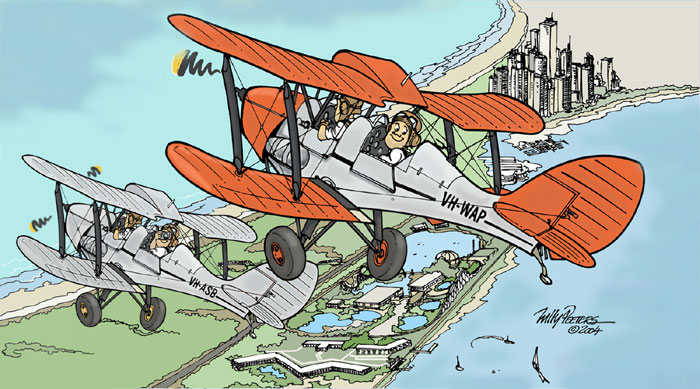
A Tiger Moth banked and dropped low over our rental car as we turned onto the
rough dirt road approaching the hangar. Parallel with our car, the silver
biplane touched down smoothly. We matched its slowing pace, side by side, on the
short drive to the car park.
“Sophisticated operation”, quipped Ian. The airstrip comprised a couple of
hundred metres of compressed sandy dirt. The hangar was a simple galvanised
metal shed. However, these basic facilities were more than adequate for the
tough, reliable little Tiger Moth. Besides, if you muted the sound of the nearby
Freeway and turned your head to disregard the encroaching red-tiled rooves of
new residential estates, you could easily imagine that you were on a 1940s
airfield hewn from the Australian bush.
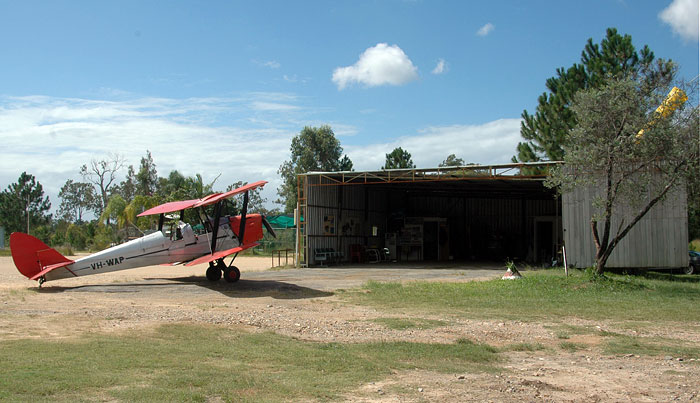
After being efficiently checked in by the helpful staff at 'Tiger Moth Joy
Rides', we were handed our leather flying helmets and shown to our aircraft.
“Don’t walk on anything painted silver”, my pilot, Peter, advised me when
stepping up onto the wing. “When you’re on the wing, grab the struts, step on
the seat and ease yourself down”.
Peter strapped me into the five-point harness then turned over the Gipsy Major
engine. Having recently sat in the cockpit of a P-40N Kittyhawk I was struck by
how small the Tiger Moth really was. In the cramped confines of the front office
- with the instruments almost at the tip of your nose and surrounded by struts
and rigging cables - the sights, smells and sounds evoke a different era.
Without ceremony the little Tiger Moth swung around to taxi to the end of the
dirt runway then, without pausing, swung back for its take-off run. Peter opened
the throttle. The tail lifted within seconds and the biplane effortlessly took
to the air.
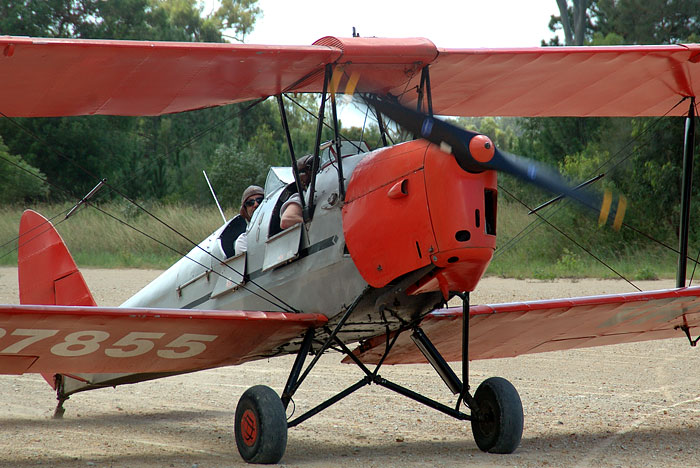
Our Tiger Moth climbed then circled to rendezvous with the second aircraft. We
continued on to the coast at 1,500 feet, with the two planes regularly changing
position.
On crossing the coast, the planes dipped their noses and descended to 500
feet over the clear blue water. The flight along the beach was spectacular with
sunshine above, imposing clouds ahead, the Pacific Ocean below and the hotels of
Surfers Paradise slipping past to our side.
The mid-point of our 25 minute flight was marked by a 180°
turn over the water.
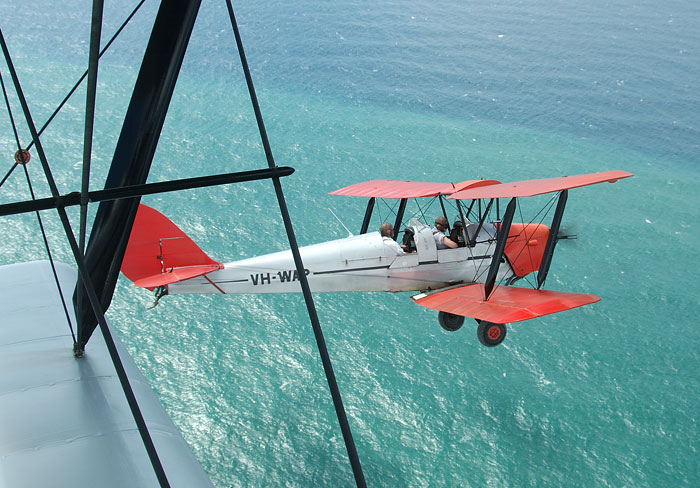
The remaining 15 minutes was spent admiring the views of
familiar landmarks from this unfamiliar perspective. When the theme parks
appeared below us I realised that we were close to the end of the flight.
Peter pushed the stick forward for a fairly steep descent. The
sandy airstrip was clearly visible out the port side of the cockpit as a broad
scar in the bush. As he had done earlier that morning over our rental car, Peter
banked, straightened then cut the revs for a perfect three-point landing.
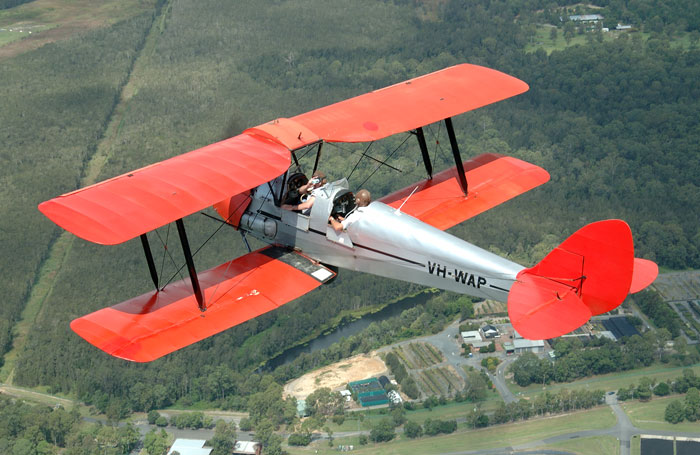
If you love aeroplanes and you have never experienced the wind
in the wires, you really should do yourself a favour. In contrast to the brute
force of powerful jet engines defying physics, these simple frames covered in
fabric seem to work with nature. Whilst airborne I was acutely aware of the
comforting drone of the engine, the sunshine, the movement of the aircraft on
the currents of air - a truly unforgettable experience.
If you are planning a holiday on the Gold Coast, this is one
ride not to miss.
The Camera and Images
For those of you interested in photography, these pictures were
taken with my brand-new Nikon D70 digital SLR camera equipped with an AF-S
Nikkor 24-120mm VR lens. "VR" stands for Vibration Reduction, Nikon's system for
stabilising images in the horizontal and vertical axes. The VR system is most
useful in low light situations, but is also helpful when photographing moving
objects.
The camera was set to "Auto" and focus was set to Five Point
Autofocus. Quality was set to "RAW". This creates Nikon-proprietary uncompressed
.NEF files, which are the quality equivalent of TIFF files at around a quarter
of the file size. The trade-off is that .NEF are more time consuming to open and
edit, and they need to be converted to a common format (eg .JPG or .TIFF) for
most external uses (ie posting to the web or commercial publishing).
The RAW images were cropped, straightened and optimised using
Adobe Photoshop. Each image was saved as a TIFF file (for later possible print
publication); then reduced to 700 pixels wide and also saved as a .JPG file for
web publication.
|
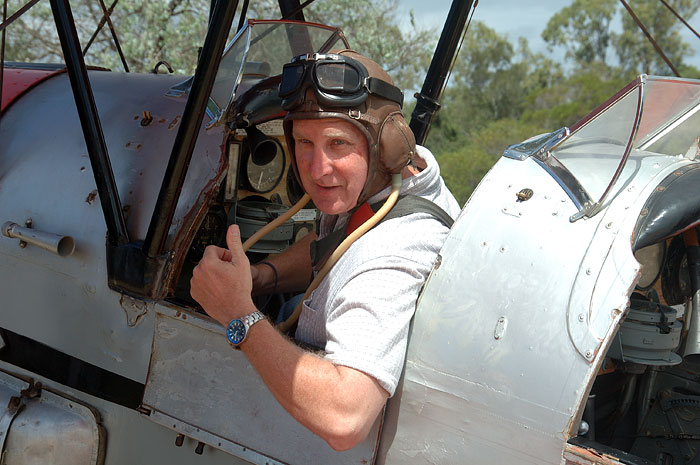
|
|
Ian Clarke -airman for a
half-hour |
Air to Air Photography
I just loved my first experience of air-to-air photography,
although initially it was a little trickier than expected. Keeping the subject
anywhere in the viewfinder was a mild challenge with both planes constantly
shifting in relation to each other - vertically and horizontally - occasional
turbulence and the frequent opportunity to bump elbows when brandishing 1.5
kilograms of camera around the cockpit.
For air-to-air photography, the digital SLR has several distinct
advantages over conventional digital cameras. The most important is that the
digital SLR has no discernible shutter delay - when you push the shutter button
the camera takes the photo instantaneously. A delay of even a fraction of a
second is likely to be disastrous in air-to-air photography, as your subject may
have moved entirely out of the frame by the time the shutter is actually
released.
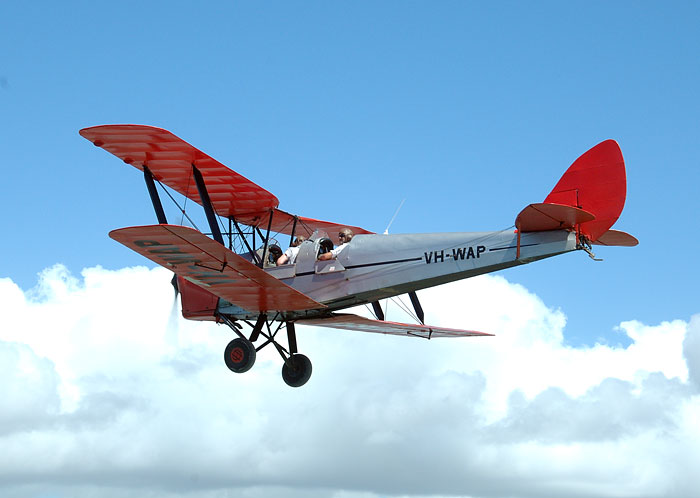
In conclusion , I was delighted with the results from my new
camera.
I will also be seeking out more opportunities for air to air
photography. If you need your portrait taken at 10,000 feet, just give me a
call!
"Tiger Moth Joy Rides" offers
scenic and aerobatic flights from Coomera Airstrip, opposite Dreamworld on
Australia's Gold Coast.
The 25 minute scenic flight as described on this
page cost AUD$160 for each passenger.
Telephone number for enquiries is +61 7 5502 7855
(from outside Australia) or 07 5502 7855 for Australian residents.
Their website may be found at
http://www.tigermothjoyrides.com.au
| A
d d i t i o n a l I m a g e s |
Click
on the thumbnail images below to view full sized.
Use the "Back" arrow on your browser to return to this page.
Text and Images Copyright ©
2004 by Brett T. Green
except Cartoon Copyright ©
2004 by Willy Peeters
Page Created 08 April, 2004
Last Updated 12 April, 2004
Back to Reference Library
|
Home |
What's New |
Features |
Gallery |
Reviews |
Reference |
Forum |
Search